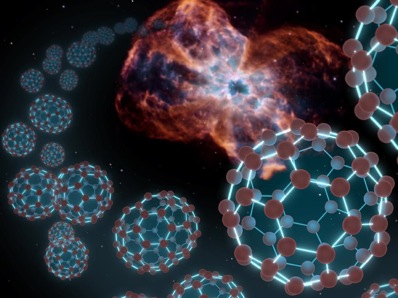



|

|

First "buckyballs"
found in space
BY DR EMILY BALDWIN
ASTRONOMY NOW
Posted: 23 July 2010


Ball-shaped carbon molecules nicknamed "buckyballs" have been found in space for the first time, 25 years after they were observed in a laboratory.
Buckyballs earn their moniker from architect Buckminster Fuller's geodesic domes, which have interlocking circles on the surface of a partial sphere. They comprise 60 carbon atoms arranged in three-dimensional, spherical structures alternating in hexagon and pentagon patterns, and belong to class of molecules formerly known as buckminsterfullerenes. Their existence was predicted in 1970 by Japanese professor Eiji Osawa, but they were not observed in laboratory experiments until 1985.
 Artist impression of buckyballs found in the remains of a once Sun-like star. (NB. Tc 1 does not show up well in images so an image of the NGC 2440 nebula has been used here for illustrative purposes). Image: NASA/JPL-Caltech & NASA, ESA, STScI. Artist impression of buckyballs found in the remains of a once Sun-like star. (NB. Tc 1 does not show up well in images so an image of the NGC 2440 nebula has been used here for illustrative purposes). Image: NASA/JPL-Caltech & NASA, ESA, STScI.
Sir Harry Kroto, who shared the 1996 Nobel Prize in chemistry with Bob Curl and Rick Smalley for the discovery of buckyballs, says, “This most exciting breakthrough provides convincing evidence that the buckyball has, as I long suspected, existed since time immemorial in the dark recesses of our Galaxy.”
Previous searches for buckyballs in space, particularly around carbon-rich stars, have been unsuccessful, perhaps surprising given laboratory experiments simulating the conditions in atmospheres of ageing stars resulted in the formation of the elusive molecule.
 Spitzer data revealed the signature of the buckyballs in their C60 and C70 forms. Image: NASA/JPL-Caltech/University of Western Ontario. Spitzer data revealed the signature of the buckyballs in their C60 and C70 forms. Image: NASA/JPL-Caltech/University of Western Ontario.
The detection was made unexpectedly while a team of astronomers were observing the remains of a Sun-like star, a planetary nebula called Tc 1, with the Spitzer Space Telescope. Analysing the infrared light emitted by the planetary nebula, the team found a perfect match to spectral data collected in the laboratory of the much-wanted buckyballs. Found in the clouds of gas and dust shed by the star, the finding suggests that the star ejected material rich in carbon. Glowing at room temperature, the science team comment that Spitzer looked in the right place at the right time – just one hundred years from now the buckyballs would likely be too cool to detect. The team also made the first detection of a relative of the buckyballs, C70, which consist of 70 carbon atoms.
“We found what are now the largest molecules known to exist in space,” says astronomer Jan Cami of the University of Western Ontario, Canada, and the SETI Institute in California. “We are particularly excited because they have unique properties that make them important players for all sorts of physical and chemical processes going on in space. We did not plan for this discovery but when we saw these whopping spectral signatures, we knew immediately that we were looking at one of the most sought-after molecules.”
|

|

|

|
|



